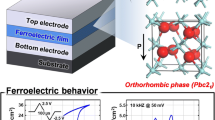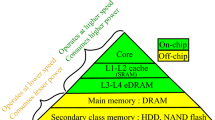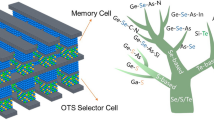Abstract
Addressing the challenges of using high-Curie temperature ferromagnetic (FM) electrodes is critical for molecular spintronics devices (MSDs) research. Two FM electrodes simultaneously chemically bonded with a thiol-functionalized molecule can produce novel MSDs to exploring new quantum mechanical phenomenon and computer technologies. For developing a commercially viable MSD, it is crucial to developing a device fabrication scheme that carefully considers FM electrodes’ susceptibility to oxidation, chemical etching, and stress-induced deformations during fabrication and usage. This paper studies NiFe, an alloy extensively used in present-day memory devices and high-temperature engineering applications, as a candidate FM electrode for the fabrication of MSDs. Our spectroscopic reflectance studies show that NiFe oxidized aggressively after heating beyond ~90 °C. The NiFe surfaces, aged for several months or heated for several minutes below ~90 °C, exhibited remarkable electrochemical activity and were found suitable for chemical bonding with the thiol-functionalized molecular device elements. NiFe also demonstrated excellent etching resistance against commonly used solvents and lithography related chemicals. Additionally, NiFe mitigated the adverse effects of mechanical stress by subsiding the stress-induced deformities. A magnetic tunnel junction-based MSD approach was designed by carefully considering the merits and limitations of NiFe. The device fabrication protocol considers the safe temperature limit to avoiding irreversible surface oxidation, the effect of mechanical stresses, surface roughness, and chemical etching. This paper provides foundational experimental insights in realizing a versatile MSD allowing a wide range of transport and magnetic studies.







Similar content being viewed by others
References
Bogani L, Wernsdorfer W (2008) Molecular spintronics using single-molecule magnets. Nat Mater 7(3):179–186
Bruckner W, Baunack S, Hecker M, Thomas J, Groudeva-Zotova S, Schneider CM (2001a) Oxidation of NiFe(20 wt%) thin films. Mater Sci Eng B 86(3):272–275
Bruckner W, Thomas J, Schneider CM (2001b) Evolution of stress and microstructure in nife (20 wt%) thin films during annealing. Thin Solid Films 385(1–2):225–229. doi:10.1016/s0040-6090(01)00754-4
Brundle CR, Silverman E, Madix RJ (1979) Oxygen interaction with ni-fe surfaces (1) leed and xps studies of Ni 76-percent-Fe 24-percent (100). J Vac Sci Technol 16(2):474–477. doi:10.1116/1.569986
Cassie ABD (1948) Contact angles. Discuss Faraday Soc 3:11–16. doi:10.1039/df9480300011
Chenakin SP (1995) Initial oxidation-kinetics of fe-ni single-crystals before and after ion-bombardment. Appl Surf Sci 84(1):91–96. doi:10.1016/0169-4332(94)00471-4
Cheng L, Yang JP, Yao YX, Price DW, Dirk SM, Tour JM (2004) Comparative study of electrochemically directed assembly versus conventional self-assembly of thioacetyl-terminated oligo(phenylene ethynylene)s on gold and platinum surface. Langmuir 20(4):1335–1341
Coey JM (2010) Magnetism and magnetic materials. Cambridge University Press, Cambridge
Coronado E, Epsetin AJ (2009) Molecular spintronics and quantum computing. J Mater Chem 19(12):1670–1671
Fedorov A, Pershin YV, Piermarocchi C (2005) Spin-photovoltaic effect in quantum wires due to intersubband transitions. Phys Rev B 72(24):245327
Gobbi M, Pascual A, Golmar F, Llopis R, Vavassori P, Casanova F, Hueso LE (2012) C-60/nife combination as a promising platform for molecular spintronics. Org Electron 13(3):366–372
Golmar F, Gobbi M, Llopis R, Stoliar P, Casanova F, Hueso L (2012) Non-conventional metallic electrodes for organic field-effect transistors. Org Electron 13(11):2301–2306
Greco SE, Roux JP, Blakely JM (1982) Oxidation of the (100) surface of a Ni-Fe alloy. Surf Sci 120(1):203–222. doi:10.1016/0039-6028(82)90282-5
Heersche HB, De Groot Z, Folk JA, Van Der Zant HSJ, Romeike C, Wegewijs MR, Zobbi L, Barreca D, Tondello E, Cornia A (2006) Electron transport through single mn-12 molecular magnets. Phys Rev Lett 96(20):206801
Hu B (2011) Fabrication and study of molecular devices and photovoltaic devices by metal/dielectric/metal structures. Ph.D. thesis, University of Kentucky. (http://uknowledge.uky.edu/cgi/viewcontent.cgi?article=1224&context=gradschool_diss)
Ingvarsson S, Xiao G, Parkin SSP, Gallagher WJ (2002) Thickness-dependent magnetic properties of Ni(81)Fe(19), Co(90)Fe(10) and Ni(65)Fe(15)Co(20) thin films. J Magn Magn Mater 251(2):202–206. doi:10.1016/s0304-8853(02)00577-2
Jurow M, Schuckman AE, Batteas JD, Drain CM (2010) Porphyrins as molecular electronic components of functional devices. Coord Chem Rev 254(19–20):2297–2310. doi:10.1016/j.ccr.2010.05.014
Kumar P (2010) Magnetic behavior of surface nanostructured 50-nm nickel thin films. Nanoscale Res Lett 5(10):1596–1602. doi:10.1007/s11671-010-9682-2
Kumar P, Krishna MG, Bhattacharya AK (2009) Effect of microstructural evolution on magnetic properties of ni thin films. Bull Mater Sci 32(3):263–270
Lad RJ, Blakely JM (1986) Breakup of oxide-films on a Ni-Fe(100) surface by s-2 impingement. Appl Surf Sci 27(3):318–328. doi:10.1016/0169-4332(86)90136-4
Lad RJ, Blakely JM (1987) Initial oxidation and sulfidation of a Ni60Fe40(100) alloy surface. Surf Sci 179(2–3):467–482. doi:10.1016/0039-6028(87)90070-7
Lad RJ, Schrott AG, Blakely JM (1984) Surface phases for sulfur and oxygen coadsorbed on Ni60Fe40(100). J Vac Sci Technol A 2(2):856–860. doi:10.1116/1.572526
Lad RJ, Schrott AG, Blakely JM (1985) Oxidation of Ni60Fe40(100) in the presence of sulfur. J Vac Sci Technol A 3(3):1282–1286. doi:10.1116/1.572526
Leuenberger MN, Loss D (2001) Quantum computing in molecular magnets. Nature 410(6830):789–793
Li DF, Parkin S, Wang GB, Yee GT, Clerac R, Wernsdorfer W, Holmes SM (2006a) An s = 6 cyanide-bridged octanuclear (Fe4Ni4ii)-Ni-iii complex that exhibits slow relaxation of the magnetization. J Am Chem Soc 128(13):4214–4215
Li DF, Ruschman C, Clerac R, Holmes SM (2006b) Ancillary ligand functionalization of cyanide-bridged s = 6 Feiii4Niii4 complexes for molecule-based electronics. Inorg Chem 45(13):7569
Luber SM, Strobel S, Tranitz HP, Wegscheider W, Schuh D, Tornow M (2005) Nanometre spaced electrodes on a cleaved AlGaAs surface. Nanotechnology 16(8):1182–1185
Miao GX, Munzenberg M, Moodera JS (2011) Tunneling path toward spintronics. Rep Prog Phys 74:036501
Misiorny M, Barnas J (2007) Spin polarized transport through a single-molecule magnet: current-induced magnetic switching. Phys Rev B 76(5):054448. doi:10.1103/PhysRevB.76.054448
Parkin S (2006) Spin-polarized current in spin valves and magnetic tunnel junctions. MRS Bull 31(5):389–394
Pasupathy AN, Bialczak RC, Martinek J, Grose JE, Donev LAK, Mceuen PL, Ralph DC (2004) The kondo effect in the presence of ferromagnetism. Science 306(5693):86–89
Petta JR, Slater SK, Ralph DC (2004) Spin-dependent transport in molecular tunnel junctions. Phys Rev Lett 93(13):136601
Salou M, Lescop B, Rioual S, Lebon A, Youssef JB, Rouvellou B (2008) Initial oxidation of polycrystalline permalloy surface. Surf Sci 602(17):2901–2906. doi:10.1016/j.susc.2008.07.012
Salou M, Rioual S, Lescop B, Calvez B, Nguyen-Vien G, Rouvellou B (2009) High-temperature oxidation of permalloy in air. Corros Sci 51(4):703–706. doi:10.1016/j.corsci.2009.02.003
Tyagi P (2008) Fabrication and characterization of molecular spintronics devices. Ph.D. thesis, University of Kentucky. (http://archive.uky.edu/handle/10225/878)
Tyagi P (2009) Molecular spin devices: current understanding and new territories. Nano 4(6):325–338
Tyagi P (2011) Multilayer edge molecular electronics devices: a review. J Mater Chem 21(13):4733–4742. doi:10.1039/c0jm03291c
Tyagi P (2012) Fabrication of tunnel junction based molecular electronics and spintronics devices. J Nanopart Res 14(10):1195
Tyagi P, Hinds BJ (2010) Mechanism of ultrathin tunnel barrier failure due to mechanical stress induced nano-sized hillocks and voids. J Vac Sci Technol B 28(5):517–521
Tyagi P, Li DF, Holmes SM, Hinds BJ (2007) Molecular electrodes at the exposed edge of metal/insulator/metal trilayer structures. J Am Chem Soc 129(16):4929–4938
Tyagi P, Friebe E, Baker C (2015a) Advantages of prefabricated tunnel junction based molecular spintronics devices. NANO 10(3):1530002. doi:10.1142/S1793292015300029
Tyagi P, Baker C, D’angelo C (2015b) Paramagnetic molecule induced strong antiferromagnetic exchange coupling on a magnetic tunnel junction based molecular spintronics device. Nanotechnology 26:305602
Tyagi P, D’angelo C, Baker C (2015c) Monte Carlo and experimental magnetic studies of molecular spintronics devices. NANO 10(4):1550056. doi:10.1142/S1793292015500563
Wu H, Wang L-S (1997) A study of nickel monoxide (NiO), nickel dioxide (ONiO), and ni (O2) complex by anion photoelectron spectroscopy. J Chem Phys 107(1):16–21
Yamada R, Noguchi M, Tada H (2011) Magnetoresistance of single molecular junctions measured by a mechanically controllable break junction method. Appl Phys Lett 98(5):053110. doi:10.1063/1.3549190
Zhu M, McMichael RD (2010) Modification of edge mode dynamics by oxidation in Ni80Fe20 thin film edges. J Appl Phys 107(10):5. doi:10.1063/1.3393966
Zhu J-GJ, Park C (2006) Magnetic tunnel junctions. Mat Today 9(11):36–45
Zwolak M, Di Ventra M (2002) DNA spintronics. Appl Phys Lett 81(5):925–927
Acknowledgments
A part of this study was supported by the National Science Foundation-Research Initiation Award (Contract # HRD-1238802), Department of Energy/National Nuclear Security Agency subaward (Subaward No. 0007701-1000043016). We thank the Air Force Office of Sponsored Research (Award #FA9550-13-1-0152) for facilitating the study of ferromagnetic electrode stability by providing instrumentation support. We also acknowledge the support from NIST’s Center of Nanoscience and Technology in facilitating the experimental studies in this paper. Pawan Tyagi thanks Dr. Bruce Hinds and the Department of Chemical and Materials Engineering at University of Kentucky for facilitating experimental work on tunnel junction-based molecular devices during Ph.D. Molecules for molecular device fabrication were produced by Dr. Stephen Holmes’s group. Any opinions, findings, and conclusions or recommendations expressed in this material are those of the author(s) and do not necessarily reflect the views of any funding agency and corresponding author’s past and present affiliations.
Author information
Authors and Affiliations
Corresponding author
Rights and permissions
About this article
Cite this article
Tyagi, P., Friebe, E. & Baker, C. Addressing the challenges of using ferromagnetic electrodes in the magnetic tunnel junction-based molecular spintronics devices. J Nanopart Res 17, 452 (2015). https://doi.org/10.1007/s11051-015-3261-5
Received:
Accepted:
Published:
DOI: https://doi.org/10.1007/s11051-015-3261-5




